A mechanochemical transformation and recovery method of sodium-containing and fluorine-containing compounds in spent cathode carbon blocks of aluminum electrolytic cells
A technology for waste cathode carbon blocks and aluminum electrolytic cells, which is applied in chemical instruments and methods, inorganic chemistry, alkali metal compounds, etc., and can solve problems such as incomplete recovery of electrolytes, deterioration of production conditions, and equipment corrosion
- Summary
- Abstract
- Description
- Claims
- Application Information
AI Technical Summary
Problems solved by technology
Method used
Image
Examples
Embodiment 1
[0067] (1) Pulverize the spent cathode carbon block of the aluminum electrolytic cell in a high-speed pulverizer, sieve it with a 200-mesh sieve, and use the undersieve to carry out mechanochemical conversion and recovery of sodium-containing and fluorine-containing compounds. Determine the mass content of sodium and fluorine elements in the waste cathode carbon powder of the unit mass aluminum electrolytic cell by chemical analysis method, and determine the CN in the waste cathode carbon powder of the unit mass aluminum electrolytic cell by chemical analysis method - The mass content of ions.
[0068] (2) Add 200g of zirconia balls to the conversion mill, weigh 100g of spent cathode carbon powder, 20g of Ca(OH) 2 Add to the transformation mill and mix well, use N 2 Replace the air in the conversion mill, then add 300g H 2 O. The conversion mill was turned on, the rotation speed was 600 rpm, the temperature was 50° C., and the conversion reaction time was 3 h.
[0069] Aft...
Embodiment 2
[0083] (1) Pulverize the spent cathode carbon block of the aluminum electrolytic cell in a high-speed pulverizer, sieve it with a 200-mesh sieve, and use the undersieve to carry out mechanochemical conversion and recovery of sodium-containing and fluorine-containing compounds. Determine the mass content of sodium and fluorine elements in the waste cathode carbon powder of the unit mass aluminum electrolytic cell by chemical analysis method, and determine the CN in the waste cathode carbon powder of the unit mass aluminum electrolytic cell by chemical analysis method - The mass content of ions.
[0084] (2) Add 200g of zirconia balls to the conversion mill, weigh 100g of spent cathode carbon powder and 30g of CaO, add them to the conversion mill and mix evenly. 2 Replace the air in the conversion mill, then add 400g H 2 O. The conversion mill was turned on, the rotation speed was 800 rpm, the temperature was 60° C., and the conversion reaction time was 2 h.
[0085] After the ...
Embodiment 3
[0094] (1) Pulverize the spent cathode carbon block of the aluminum electrolytic cell in a high-speed pulverizer, sieve it with a 200-mesh sieve, and use the undersieve to carry out mechanochemical conversion and recovery of sodium-containing and fluorine-containing compounds. Determine the mass content of sodium and fluorine elements in the waste cathode carbon powder of the unit mass aluminum electrolytic cell by chemical analysis method, and determine the CN in the waste cathode carbon powder of the unit mass aluminum electrolytic cell by chemical analysis method - The mass content of ions.
[0095] (2) Add 200g of zirconia balls to the conversion mill, weigh 100g of spent cathode carbon powder and 20g of BaO, add them to the conversion mill and mix evenly, and use N 2 Replace the air in the conversion mill, then add 350g H 2 O. The conversion mill was turned on, the rotation speed was 1000 rpm, the temperature was 80° C., and the conversion reaction time was 3.5 h.
[0...
PUM
| Property | Measurement | Unit |
|---|---|---|
| particle size | aaaaa | aaaaa |
| size | aaaaa | aaaaa |
Abstract
Description
Claims
Application Information
 Login to View More
Login to View More - R&D
- Intellectual Property
- Life Sciences
- Materials
- Tech Scout
- Unparalleled Data Quality
- Higher Quality Content
- 60% Fewer Hallucinations
Browse by: Latest US Patents, China's latest patents, Technical Efficacy Thesaurus, Application Domain, Technology Topic, Popular Technical Reports.
© 2025 PatSnap. All rights reserved.Legal|Privacy policy|Modern Slavery Act Transparency Statement|Sitemap|About US| Contact US: help@patsnap.com



